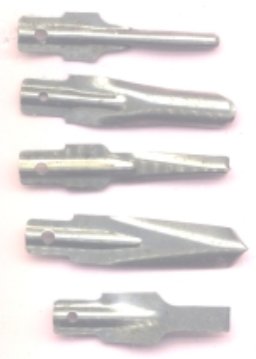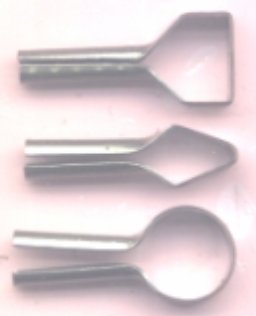Probably developed from prehistoric flaked stone scrapers, handles were added later to improve grip. These are pulled or pushed to shave thin layers of material from surfaces.
Still later, to cut deeper, longer handles were added to form an axe, a hoe or an adze, and later yet by placing the cutting edge at the end of the handle similar to an arrow, spear or spade, chisels were developed to remove material from surfaces, gouge out slots, finish rough holes and chop items to length. Often the division between scrapers and chisels is not clear.
There are 3 types of chisels generally used in modelling; plastic, wood and metal. Basically they are sharpened wedges that split pieces or chips from the work. Some knife blades are designed for chiselling. Files, saw blades and bur cutters for rotary tools are comprised of a series of chisels. Drill bit tips are chisels. Abrasive wheels and sand paper use a multitude of fine chisels. Even lathe bits may be considered chisels. Only the single edged type with handle will be covered here. In some applications they are pushed by hand, but in more stubborn cases they are tapped by a hammer. The basic skill required is to learn to control the depth and length of each cut without gouging.
Commonly used to remove cast on, unwanted detail from structures, shells and boilers, and obstructions in coupler boxes or mounts, they are more often pushed here. For wood, plastic and soft metal, flat #17 or #18 and shaped carving knife blades are commonly used; but since the edge ends are sharp corners, they can easily gouge the surface. Corners may be rounded to reduce. Blade #16 can be used for angle cuts and in sharp corners. For easier operation, use with beveled face toward surface and a very low attack angle. The back or side edges of most blades make excellent, no cost, scrapers for removing flash and gate marks.

Note: Adjust brightness and contrast for optimum viewing.
XACTO TYPE CHISEL KNIFE BLADES
#16,
#17
#18.
Called gouges, some are shaped into Vees or arcs for grooving and other cocave work.

Note: Adjust brightness and contrast for optimum viewing.
SHAPED OR GOUGING BITS.
Arc
Arc.
Vee.
Vee
Flat.
Some called routers are designed for draw type cutting.

Note: Adjust brightness and contrast for optimum viewing.
ROUTERS
1/2" squqre.
Vee.
1/2" circle.
Sharpened screw drivers and dental tools are often used, especially in tight spaces. During my Navy days, sharpened jeweler's screw drivers were the only things available. Mantua zamac frames were often chiseled out to accommodate KaDee boxes. Later, when an orthodontist friend gave me his old dental tools, they were shaped and sharpened for many types of work. Suitable for scrapers or chisels, a very wide range of shapes and sizes may be found in surplus outlets. Needle pointed hooks make good scribers for board type siding.

Note: Adjust brightness and contrast for optimum viewing.
Dental tool as chisels.
Flat spatula sharpened.
Curved spoon for concave surfaces.
Squadron scraping chisel for more delicate work.
More recently specialty tools have been marketed. This chisel has one slightly curved, very sharp, beveled edge, which is easily pushed to shave off cast-on detail, from rivets to ladders. Once use is mastered, very little, if any, touch-up will be required. Due to the sharp edge, use on metal should be avoided.

Note: Adjust brightness and contrast for optimum viewing.
Micro-Mark detail removing chisel.
From left Tip bevel ends at light line about 1/3 in on dark area.
Since the beveled edge sets the handle at a convenient angle and serves as a guide on flat surfaces to eliminate gouging, this is an excellent tool for the inexperienced. As an adjunct, a smaller version would be highly desirable.
Wood carving knife sets often include sturdier chisel blades with curved, vee and flat tips. Although primarily designed for wood, they work well with some plastics.
Available in many shaped tips, wood lathe gravers can be used as chisels elsewhere. Of very similar design, more robust gravers are available for free turning of metals. These work well on zamac and brass castings.
Similar in design but with edges along the blades, these scrapers are for deburring holes and edges on metal.

Note: Adjust brightness and contrast for optimum viewing.
DEBURRING SCRAPERS .
triangular
curved
For benchwork and heavier jobs, hammer driven, wood chisels are used. In many cases, they are used in lieu of a plane, which is essentially a chisel blade mounted in a housing. Some have wooden handles with or without striking surfaces, while others are solid metal, intended for use solely with a hammer. The former are also offered as paint scrapers with thin, flexible blades useful for carving and scraping plaster scenery. As a rule, only one side of hammer driven chisels is bevel sharpened and is used away from the work surface. Some have a slight angle bend at the blade=shank juncture to permit a flat attack angle and still provide hammer clearance at the shank end. Due to their very sharp, acute edges, they are very easily damaged by metal.

Note: Adjust brightness and contrast for optimum viewing.
SMALL PAINT SCRAPER, 1" WIDE.

Note: Adjust brightness and contrast for optimum viewing.
BENT, HAMMER WOOD CHISEL, 1/4" .
For harder metals and stone, more obtuse, double bevel edged, solid, cold steel chisels are used almost exclusively with a hammer. They are hardened to resist wear at both ends. Used for shearing, cutting, slotting and even sculpting. entry angles are often quite steep, including vertical.
Michelangelo may be considered, the greatest "chiseller" the world has ever known. (pun)

Note: Adjust brightness and contrast for optimum viewing.
BENT COLD CHISEL, 5/16" wide..
An odd type of chisel is used to stamp objects. Usually available in sets, they contain standard fonts of characters for data and identification. Some are specially formed for logos.
For those of us, who are lazy or in a hurry, miniature jack hammers are available. Reciprocating, vibrator type power tools often have chisel tips or some may be made. Dating back to the late forties, this Burgess Vibrotool provided one. The stroke is adjustable by the knob on the upper right. It has more than enough power to chisel most metals. Removing raised push pin pads from zamac frames is a snap. As with all power tools very strict attention to control must be maintained to avoid overshooting and wandering.

Note: Adjust brightness and contrast for optimum viewing.
Burgess Vibrotool with chisel tip..
A more recent tool is the Wald File/Sander, which comes with file and sanding wand tips. No stroke control is available. Old worn-out files can be ground down to form chisels. Although light powered, its more than adequate for most modelling jobs. Unfortunately no adapter to hold other tips is available, but one could be made easily.

Note: Adjust brightness and contrast for optimum viewing.
Wald File Sander with file tip..
If care is taken, many of the rotary tool burr bits can perform rapid, rough chiselling , especially on metal.
Since milling bits are chisels, for more precise work, a MILLING MACHINE _may be used. But developing the correct setup may be difficult, especially on odd shapes.
Although chiselling is not difficult, only through experience can the right feel, control and methods be attained.
BACK TO KNIVES
BACK TO TOOLS INDEX
